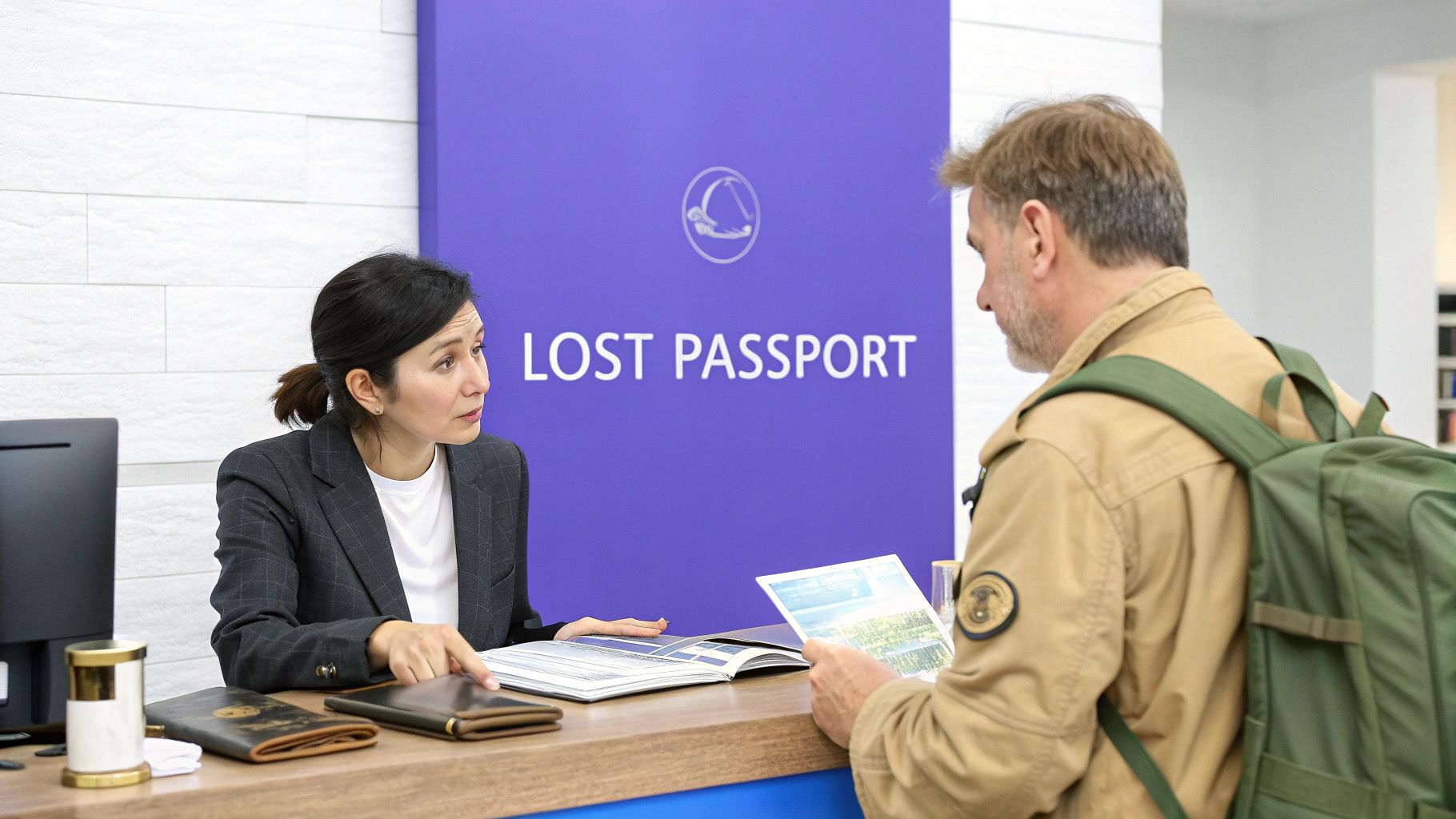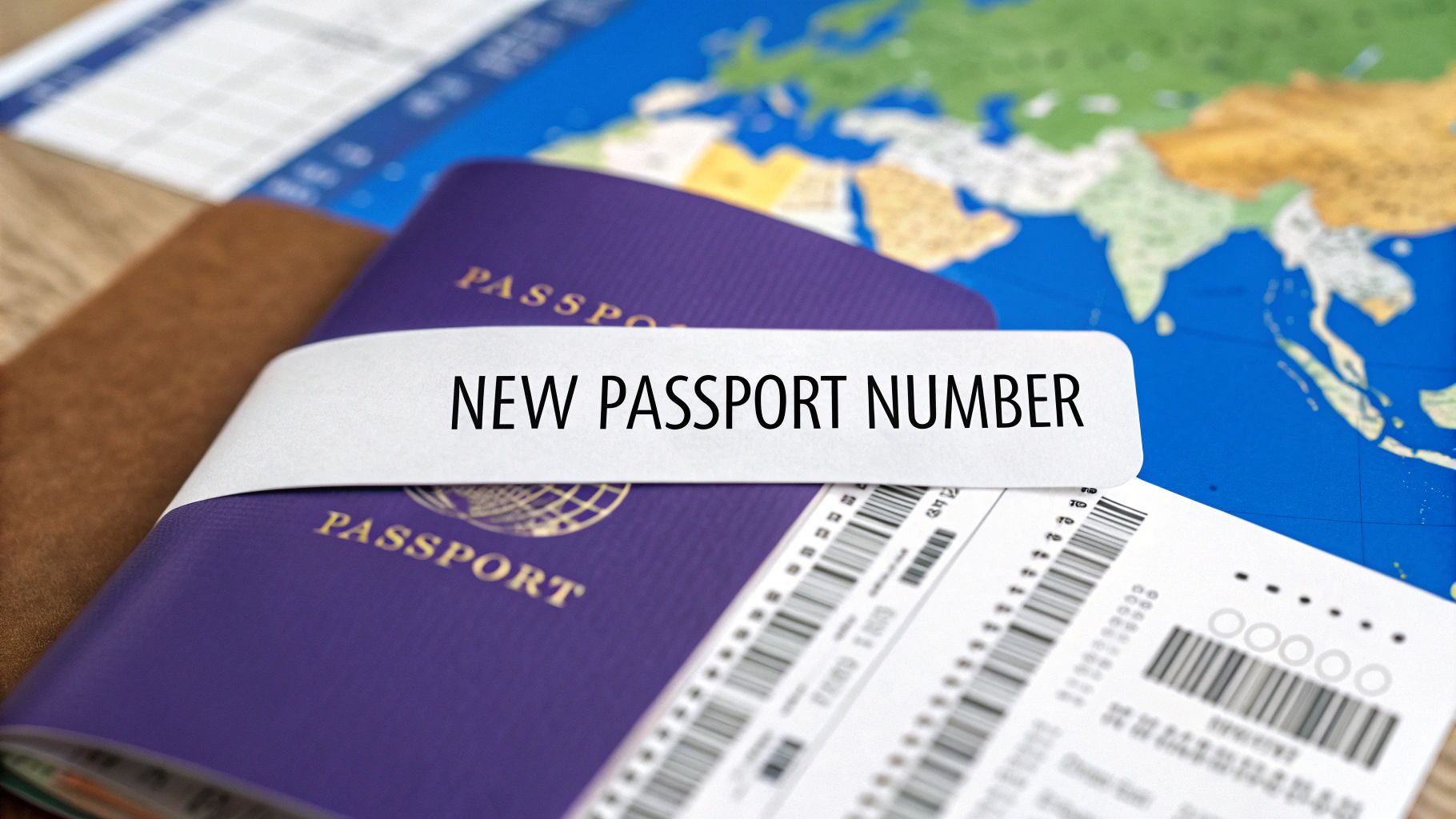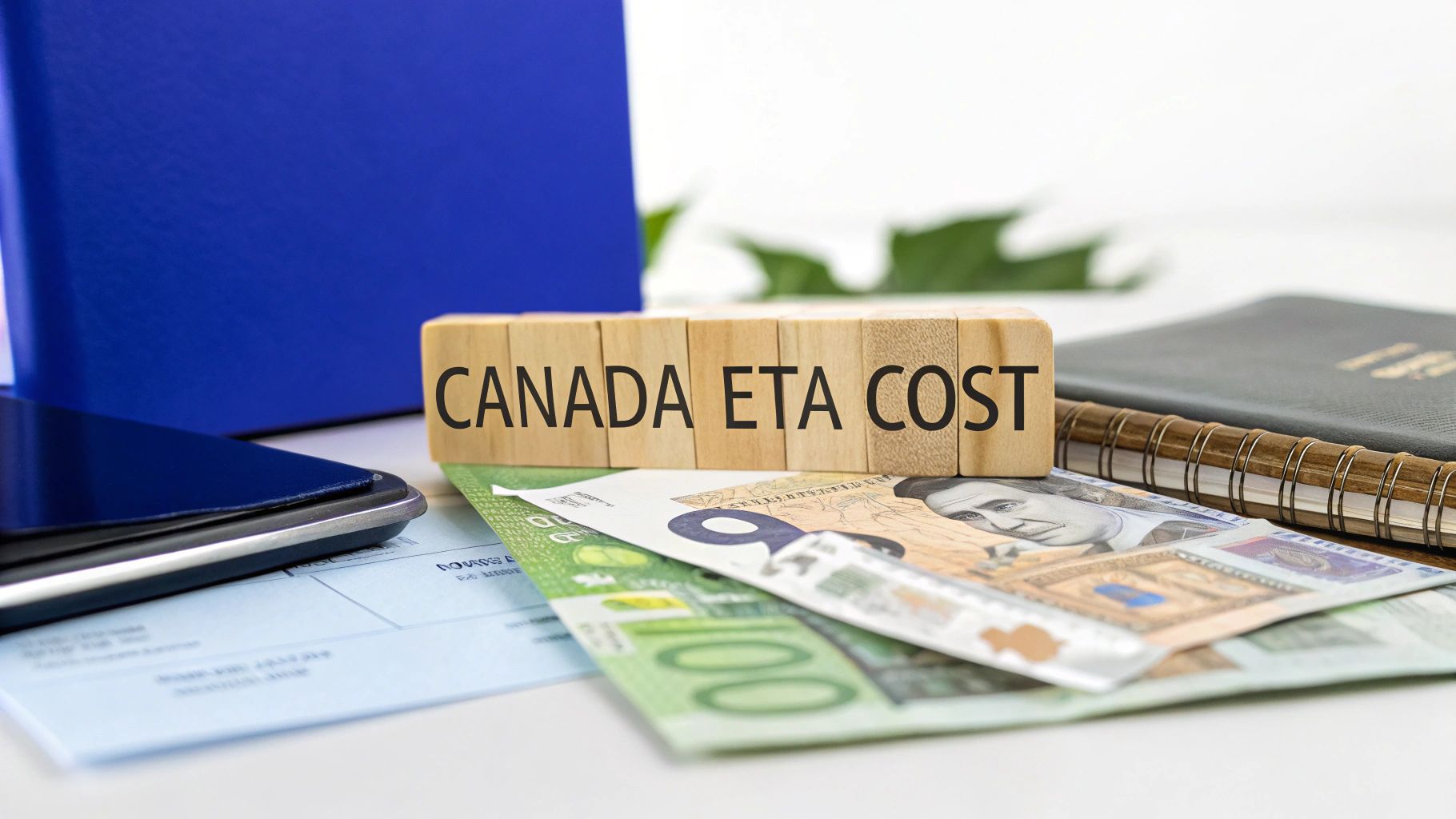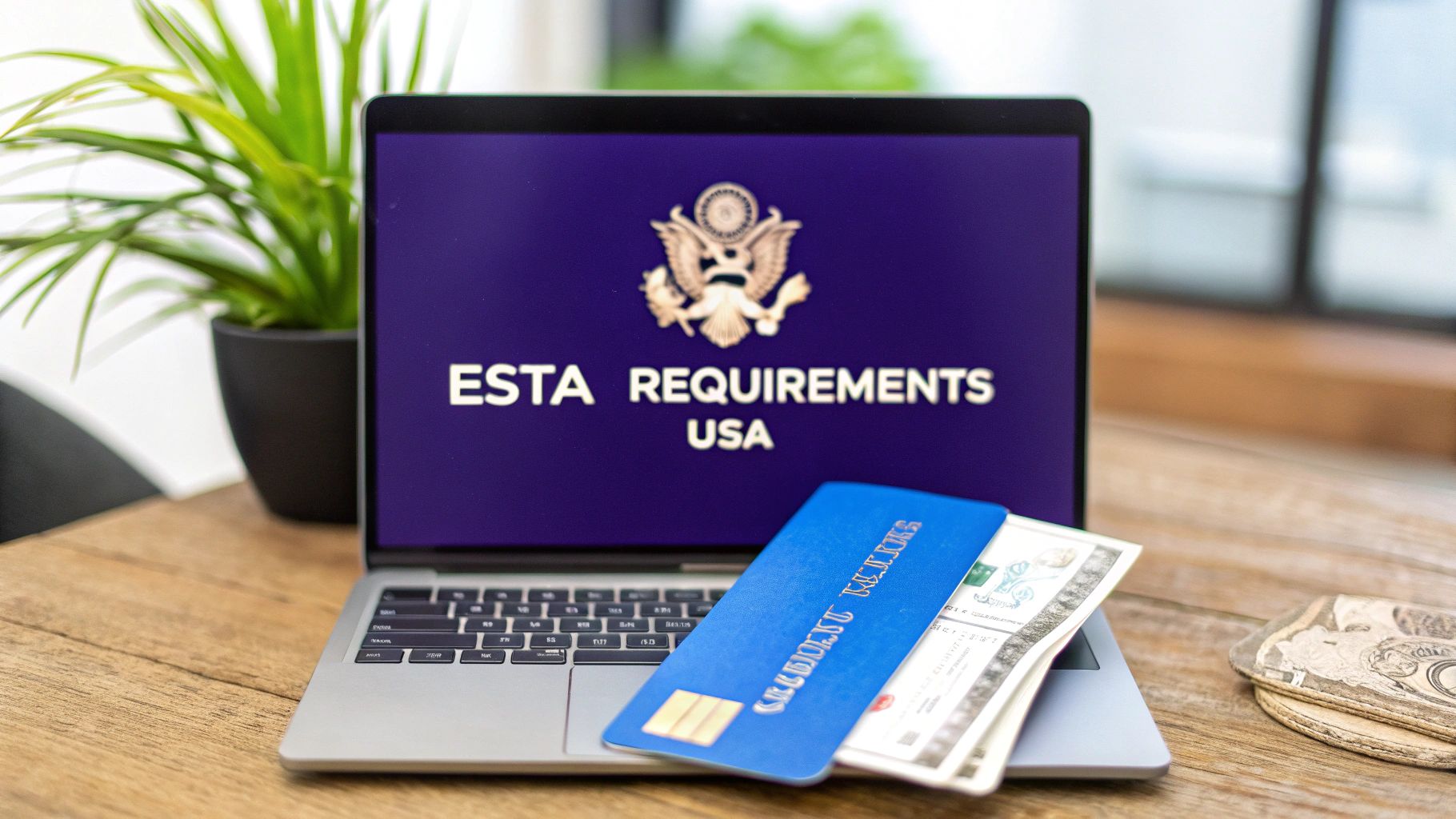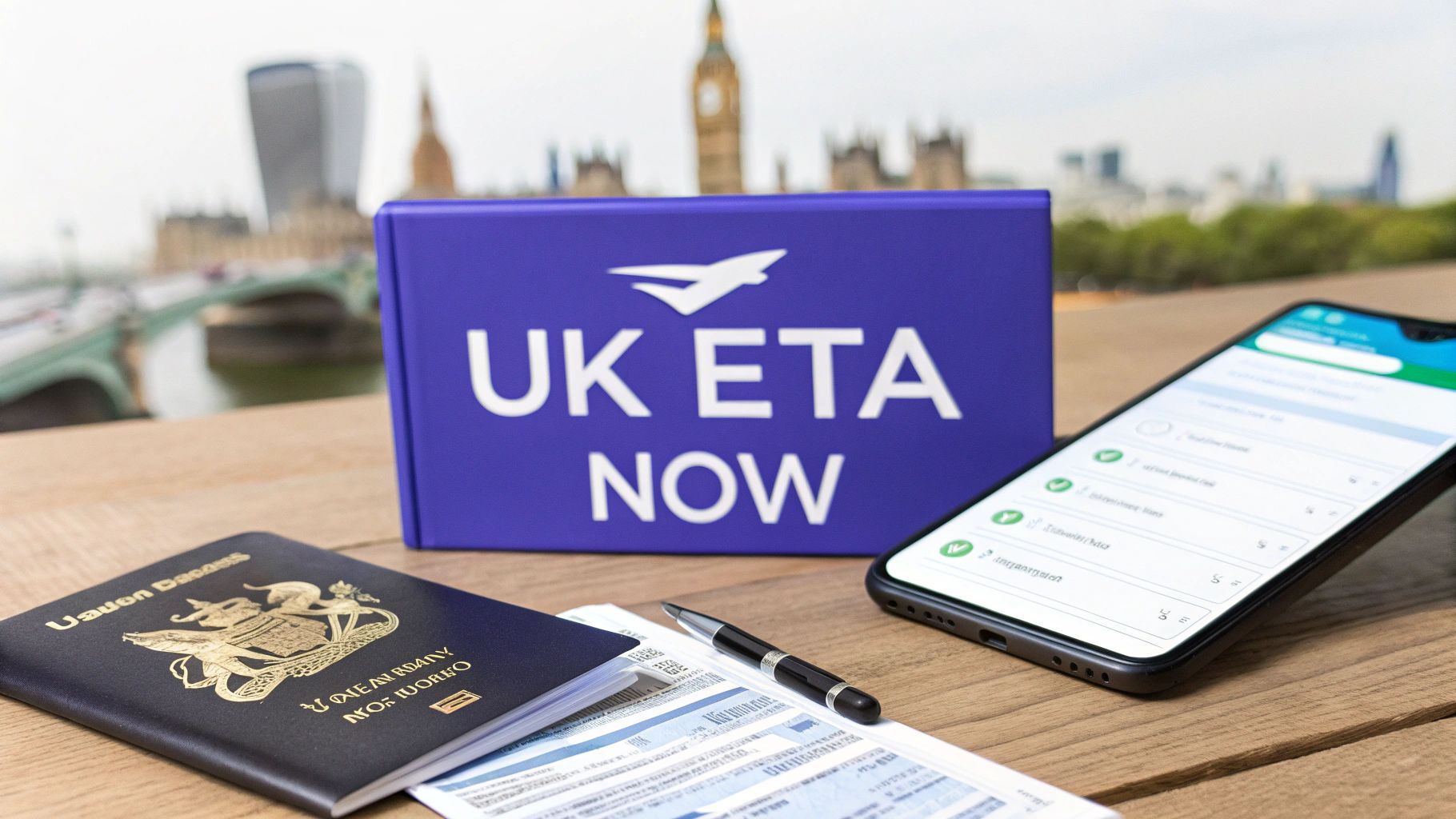
How to Apply for Visitor Visa UK The Right Way
So, you're planning a trip to the UK. That's fantastic. But before you start dreaming of London's skyline or the Scottish Highlands, there's the small matter of getting your entry sorted. For many people, this means getting a Standard Visitor Visa. It’s the most common route for tourism, family visits, or short business trips.
Navigating this process involves proving who you are, what you plan to do, and that you have the means to do it, all capped off with a visit to a visa application centre for your biometrics. It sounds like a lot, but breaking it down makes it manageable.
Understanding Your UK Visitor Visa Journey
First things first: what do you actually need? The UK’s rules aren't the same for everyone; it all comes down to your nationality.
Many travellers will need what's called a Standard Visitor Visa. This is the classic visa that allows you to stay in the UK for up to six months for things like sightseeing, seeing family, or attending a business conference.
But things are changing. The UK has been rolling out a new system called the Electronic Travel Authorisation (ETA). Think of it less like a visa and more like a digital green light. It’s for people from countries that don’t need a visa for short trips, like citizens from many Gulf states and soon, other visa-exempt nations. The ETA is simply a pre-travel clearance that gets linked to your passport.
Visitor Visa vs UK ETA
So, how do you know which one applies to you? It's simple: it depends on your passport.
The absolute best thing you can do is check the official GOV.UK website. It will tell you exactly what you need based on your citizenship. Getting this wrong can cause major headaches, from long delays to being turned away at the border. Trust me, it's not a situation you want to be in.
Let's quickly compare the two.
UK Entry Requirements At a Glance
The table below breaks down the key differences between the Standard Visitor Visa and the UK ETA to help you quickly see which might apply to your situation.
| Requirement | Standard Visitor Visa | UK ETA (Electronic Travel Authorisation) |
|---|---|---|
| Who Needs It? | Nationals of countries that require a visa for short UK stays. | Nationals of specific visa-exempt countries. |
| Application Type | Detailed online form, extensive supporting documents, and an in-person appointment. | Simple online application with minimal documentation. |
| Purpose of Visit | Tourism, family visits, specific business activities. | Tourism, family visits, transit, and short business trips. |
| Processing Time | Typically 3-8 weeks, but can vary. | Usually within 72 hours, often much faster. |
| Validity | Usually valid for 6 months per visit. | Valid for 2 years for multiple visits (up to 6 months each). |
| Effort Level | High. Requires careful preparation and evidence gathering. | Low. A quick and straightforward online process. |
As you can see, the ETA is a much simpler process, but it's only available to certain nationalities. Always confirm your specific requirements before starting an application.
If you find out you're eligible for the new ETA, that's great news! The application is much quicker, but it still demands accuracy. A tiny typo could flag your application and cause a delay. To make sure your UK ETA application is perfect, a third-party application assistance provider can be a lifesaver.
To simplify your ETA application and increase your chances of approval, consider using AssistEntry — their experts guide you through the entire process, starting from just $79. Their service includes full verification of the application, error-checking, and compliance review, which significantly increases the chances of approval due to expert handling.
No matter which path you need to take—a full visa or an ETA—being prepared is everything. This guide is here to walk you through how to apply for a visitor visa to the UK, giving you the confidence to build a solid application that gets approved.
For a deeper dive into this topic, you can learn more about securing a travel visa for the UK in our other detailed article.
Confirming You're a Genuine Visitor

Before you fill out a single form, let's talk about the most critical part of any UK visitor visa application: the "genuine visitor test." This isn't just about ticking boxes. It's about convincing an immigration officer that your intentions are exactly what you say they are.
At the end of the day, they need to be sure of two things: first, that you'll leave the UK when your visit is over, and second, that you have enough money to support yourself without working or needing public funds.
The UK handles a staggering number of these applications—over 2 million in recent years. While the average approval rate hovers around 77%, that number can be deceiving. For instance, applicants from the UAE have a 99.4% approval rate, showing just how much your personal circumstances and home country matter.
Proving You’ll Return Home
The Home Office is laser-focused on one big question: will you go home? A huge part of your application is about showing you have strong ties to your home country—a life you fully intend to return to. Just saying you'll leave isn't enough. You need to prove it.
Think of it as building a case for your return. Here's what they look for:
- A stable job: A letter from your employer is gold. It should confirm your position, salary, and that your time off has been approved. It proves you have a job to come back to.
- Family commitments: Are you married? Do you have children? Documents like marriage and birth certificates show you have deep roots and responsibilities at home.
- Property ownership: Owning a house or land is a powerful anchor. Title deeds or mortgage statements are excellent proof.
- Ongoing education: If you're a student, get a letter from your school confirming you're enrolled and when you're expected back for your studies.
You're essentially answering the question, "What's waiting for this person back home?" Your documents need to paint a clear, compelling picture.
Showing You Can Afford Your Trip
The second piece of the puzzle is money. You need to show you can pay for your entire trip without working in the UK. This isn't just about having cash in the bank; it’s about showing where it came from and that it's genuinely yours to spend.
Key Takeaway: Your financial story must be consistent. Don't just dump a large sum of money into your account right before you apply—that's a major red flag for immigration officers. A history of stable finances over several months is far more convincing.
Here’s what they want to see:
- A steady income: Your bank statements should show a regular salary or other income that lines up with what your employer's letter says.
- Enough savings for your trip: Plan a realistic budget for flights, accommodation, and spending money. Your bank balance needs to show you can cover it comfortably.
- A clear source of funds: If you received a large gift of money for your trip, get a letter from the person who gave it to you explaining the situation.
For example, if you estimate your trip will cost £2,000, your bank statements for the last six months should show that you can easily afford this. Tying your bank statements to your payslips helps create a strong, believable financial narrative.
Passing the genuine visitor test really comes down to being transparent and providing solid proof. For a closer look at the documents you’ll need, check out our complete guide on travel to UK visa requirements.
Getting Your Paperwork in Order

When you apply for a visitor visa to the UK, your documents are everything. This is where you stop telling the Home Office your story and start proving it. Every single paper you submit is a piece of evidence backing up your claim of being a genuine visitor.
Think of your application file as your personal sales pitch to the immigration officer. It needs to be professional, easy to follow, and absolutely complete. One missing document can cause serious delays or even a flat-out refusal, so this is the stage where you need to be meticulous.
The Non-Negotiables: Core Documents for Every Applicant
No matter who you are or why you're visiting, a few key documents form the bedrock of your application. Get these wrong, and your chances of approval drop significantly.
- Your Valid Passport or Travel Document: This is the big one. It must be valid for your entire planned trip to the UK and have at least one totally blank page (both sides) for the visa sticker to be placed.
- Proof You Can Fund Your Trip: This is probably the most closely examined part of any application. You’ll need to provide bank statements, usually for the last six months, to prove you have a stable financial situation. They need to clearly show your income, savings, and what you typically spend money on.
- Your Itinerary and Accommodation Plans: You don't need to book expensive, non-refundable flights just yet, but you do need a solid plan. Provide a detailed travel itinerary, including proposed flight routes, proof of where you'll stay (like hotel reservations or an invitation letter from your host), and a general day-by-day outline of your plans.
A huge red flag for visa officers is seeing a large, unexplained sum of money deposited into your account right before you apply. They’re looking for a consistent, believable financial history—not a last-minute cash injection.
Building a Stronger Case with Supporting Documents
Once you have the essentials covered, supporting documents are your chance to add real weight and credibility to your application. This is how you paint a full picture of your life back home and convince the officer you have every reason to return.
For a deeper dive, check out our complete guide on the specific documents needed for a UK visitor visa.
Document Checklist for UK Visitor Visa
To keep you on track, I've put together this quick checklist. Use it to make sure you have everything you need when you apply for a visitor visa to the UK.
| Document Category | Specific Item | Key Considerations |
|---|---|---|
| Identity | Valid Passport | Must have at least one blank page and be valid for your entire stay. |
| Financials | 6 Months of Bank Statements | Must show a stable income and sufficient funds to cover your trip. |
| Employment | Letter from Employer | Should confirm your role, salary, start date, and approved leave. |
| Accommodation | Hotel Bookings or Invitation Letter | Provide clear proof of where you will be staying during your visit. |
| Ties to Home | Property Deeds, Family Certificates | Evidence that you have compelling reasons to return home after your trip. |
| Travel Plans | Detailed Itinerary | Outline your planned activities, cities to visit, and a rough schedule. |
Gathering these documents methodically is the best way to present a strong, believable application.
Handling Special Situations
Your unique circumstances might require a few extra documents. For example, if a friend or family member in the UK is sponsoring your trip, they'll need to provide their own financial documents and a formal letter of invitation. That letter should clearly explain their relationship to you and confirm they can support you financially.
One last critical point: if any of your documents aren't in English or Welsh, you absolutely must provide a certified translation. This isn't just a simple Google Translate printout. It has to come from an accredited source and include a statement confirming its accuracy, the date, and the translator's full contact details. An improper translation can make a key document completely useless.
Your goal here is simple: leave zero room for doubt. A well-organized, complete set of documents presents a professional and compelling case for your visit.
Completing the Online UK Visa Application Form
This is it—the online application form on the GOV.UK website. Everything you've gathered so far comes together here to tell your story to the immigration officials. Every single answer counts, so accuracy is everything.
Think of this form as a detailed digital interview. You'll be asked for personal details, your travel history, your financial situation, and exactly why you want to visit the UK. My advice? Go slow, check every entry twice, and be ready for some surprisingly detailed questions.
Navigating Tricky Questions
From my experience, a few sections on this form consistently cause problems for applicants. The big one is your immigration history. The form will directly ask if you've ever been refused a visa for any country, not just the UK.
It's tempting to think that leaving out a past refusal might help your chances. Don't do it. This is a massive mistake. The Home Office has access to shared international records, and any dishonesty will almost guarantee a refusal and could even get you a 10-year ban from entering the UK.
Expert Tip: Always, always declare previous visa refusals. The trick isn't to hide it, but to explain what happened honestly and, most importantly, show how your circumstances have improved since then. A past refusal isn't an automatic "no," but hiding one is.
The financial section is another common stumbling block. You'll need to declare how much you think your trip will cost and who's footing the bill. Be realistic. Make sure the numbers you enter here line up perfectly with the bank statements and payslips you're submitting. Any mismatch will immediately raise a red flag.
The entire visa process, from the moment you hit "submit" to getting a decision, involves several key stages. This infographic gives a great visual summary of the typical flow.

As you can see, the average processing time is about six weeks, which really drives home the point: apply well before you plan to travel!
Managing Fees and Payments
After you’ve filled out the entire form, the last step before booking your biometrics appointment is paying the fees online. You'll need to cover two main costs:
- The Visa Application Fee: For a standard visitor visa (good for up to six months), the current fee is £115. If you're applying for a longer-term visa, expect this cost to be higher.
- The Immigration Health Surcharge (IHS): Good news here. This fee usually does not apply if you're just getting a Standard Visitor Visa for six months or less. It's typically for longer-term applicants.
You'll need a valid debit or credit card to make the payment through the secure government portal. Once the payment goes through, you'll get a confirmation receipt and be prompted to book your appointment at a nearby visa application centre.
I know the form can feel overwhelming, especially with so much riding on it. For a more detailed look at the entire journey, check out our guide on how to apply for a visa to England. It's packed with extra tips to help you build the strongest application possible.
Your Biometric Appointment and Final Submission
You’ve submitted the online form and paid the fee—nice work. Now comes the in-person part: booking and attending your biometric appointment at a designated visa application centre (VAC). This step is non-negotiable.
This isn't just a quick photo op. It’s where you'll provide your fingerprints and have a digital photograph taken, forming a core part of the UK's security checks. It’s a mandatory step for anyone who needs to apply for a visitor visa to the UK.
https://www.youtube.com/embed/LCWr-TJrc0k
When you go, be sure to bring your valid passport, the appointment confirmation printout, and a copy of the document checklist you received after submitting your online application. Don't forget these.
What to Expect at the Visa Application Centre
The appointment itself is usually pretty quick and straightforward. A staff member will call you up, guide you through scanning your fingerprints on a digital machine, and take your photo. They'll also collect your passport and any other physical documents you were asked to bring.
While you're there, you'll likely be offered a few different service levels. It’s good to know what they are ahead of time so you can decide what’s right for you.
- Standard Service: This is the default. Your application goes into the regular processing queue.
- Priority Service: For an extra fee, your application gets moved to the front of the line. You can often get a decision within five working days.
- Super Priority Service: This is the fastest—and most expensive—option. You can typically expect a decision by the end of the next working day.
Is the extra cost worth it? It really depends on your travel dates and your budget. If your trip is just around the corner, paying for a priority service can save you a lot of stress and uncertainty.
Finalizing Your Submission
Once your biometrics are taken, the VAC staff will officially forward your entire application package to UK Visas and Immigration (UKVI) to be reviewed. At this point, you've done everything you need to do. Now, the waiting begins.
It's worth noting that interest in visiting the UK remains incredibly high. Recent government figures showed net migration to the UK at 431,000. While that number is down from previous peaks, it shows just how many people are still keen to enter the country for tourism, family visits, and business. This consistent demand is why the visitor visa system is such a crucial part of the UK's immigration framework. You can dig deeper into these trends on the Migration Observatory's website.
A Quick Note on the UK ETA: If you're from a visa-exempt country (like the US, Canada, or Australia), your process is much, much simpler. You don't need a full visa or a biometric appointment. Instead, you'll just need an Electronic Travel Authorisation (ETA), which is a quick online application that's usually approved within 72 hours.
If you're one of the lucky ones eligible for the UK ETA, the application is fast, but you need to be precise. A tiny typo can cause delays or even a rejection.
To make sure everything is perfect and avoid any headaches, you might want to get an expert to look it over. For a smooth and hassle-free UK ETA application, AssistEntry's UK ETA service is a fantastic option. Their team double-checks every detail for accuracy before it's submitted, which seriously boosts your chances of a quick approval. With services from just $79 (all costs included), it’s a smart investment to keep your travel plans on track.
What Happens After You Apply? (And How to Avoid Common Pitfalls)
So, you’ve submitted your application and had your biometrics taken. Now comes the hard part: the wait. This is often the most nerve-wracking stage, but knowing what's happening on the other side—and what mistakes to avoid from the start—can make all the difference.
Typically, you can expect a decision on a standard UK visitor visa in about three weeks. However, this can shift depending on how busy the application centre is and the specifics of your case. Most VACs offer an online tracking portal, which gives you a basic status update while you wait.
Understanding Why Visas Get Refused
Unfortunately, a visa isn't guaranteed. Getting a refusal is tough, but understanding the common reasons why it happens is the best way to prevent it. Most refusals boil down to just a few key issues.
- Shaky Financials: This is a big one. It's not just about having money in the bank; you have to prove where it came from. Large, last-minute cash deposits right before you apply are a massive red flag for immigration officers and can sink an otherwise good application.
- Weak Ties to Home: The officer reviewing your case needs to be 100% convinced you’ll go home after your visit. If you don't provide solid evidence of your job, family responsibilities, or property back home, they may assume you intend to overstay.
- Inconsistent Information: If your application form tells one story and your documents tell another, it immediately creates doubt. For example, if you say the trip will cost £2,000 but your bank statements don't reflect that, it undermines your credibility.
Family visits are a huge driver for visa applications, and they are often looked at very closely. Recent data shows that while long-term family settlement is down, the visitor visa remains a critical pathway for connecting families. This highlights just how important it is to get every detail right. You can read more about how family routes affect UK immigration statistics on Laura Devine Immigration's website.
Nailing Your Application and Avoiding Mistakes
The secret to a successful application is simply being meticulous. Double-check everything. Then check it again. Make sure your story is clear, consistent, and backed up by every single document you provide. Small errors can create big headaches.
Of course, mistakes happen. If you’ve already hit "submit" and realize you made a typo, don't panic. There are ways to handle it. For those applying for an ETA, we've put together a guide on how to fix a mistake on your UK ETA application that walks you through the steps.
For travelers who are eligible for the UK's Electronic Travel Authorisation (ETA), the process is much simpler, but accuracy is still key. Even a small mistake can cause a delay or rejection.
This is where getting an expert to review your application can be a lifesaver.
Using a service like AssistEntry ensures every field on your UK ETA application is checked for accuracy and compliance before it's sent off.
Want to take the guesswork out of your ETA application? Consider using AssistEntry. Starting from just $79, their experts will guide you through the whole process, including a full verification and error check. It's a small price for total peace of mind.
Got Questions About the UK Visitor Visa? We've Got Answers
When you're dealing with the UK Standard Visitor Visa, a few key questions always seem to pop up. Getting these details right is crucial—it can be the difference between a smooth approval and a frustrating refusal.
Let's break down some of the most common things applicants ask.
Can I Work or Study While I'm in the UK on a Visitor Visa?
This is a big one, and the answer is a firm no.
The rules are incredibly strict here. You absolutely cannot take on paid or unpaid work for a UK-based company or as a self-employed person. You're also not allowed to enroll in any long-term courses.
Think of the Standard Visitor Visa as being purely for tourism, visiting family and friends, or for very specific, short-term business activities like attending a conference. Trying to work on this visa is a fast track to serious immigration trouble, which could include getting banned from the UK in the future.
What's the Difference Between a UK Visitor Visa and the UK ETA?
It's easy to get these two confused, but they are completely different things.
A UK Visitor Visa is the full, formal application. It’s for nationals from many countries and involves filling out detailed forms, gathering a mountain of supporting documents, and providing your biometric information.
On the other hand, the UK Electronic Travel Authorisation (ETA) is a much simpler digital permission slip. It's for people from visa-exempt countries (like the US or Australia) who don't need a full visa for short trips. The ETA isn't a visa; it’s just a pre-screening step to make travel smoother and more secure.
Not sure which one you need? Always double-check the official GOV.UK website based on your passport nationality before you do anything else.
My Visitor Visa Application Was Refused. Now What?
First, don't panic. A refusal isn't the end of the road. Yes, you can absolutely reapply.
The most important thing is to read your refusal letter from the Home Office very carefully. It will spell out exactly why they said no. Your job in the new application is to directly address every single one of those reasons with stronger, clearer evidence.
Just sending in the same application again is a guaranteed way to get another refusal. This is where getting an expert to look over your case can be a huge help in building a much more convincing application for your second try.
For those eligible for the new digital system, the UK ETA application is faster but still requires precision. A minor error can cause unnecessary delays and disrupt your travel plans.
To make sure your application is perfect from the start, you might consider using a third-party application assistance provider to help. Their expert review can spot common mistakes before they become a problem, giving you a much better shot at getting approved without a hitch.
For a smooth and stress-free UK ETA application, AssistEntry provides expert verification to ensure your form is accurate and compliant. Their service, starting from just $79 (all costs included), is designed to give you peace of mind and help you avoid common pitfalls. To simplify your UK travel plans, consider using AssistEntry’s UK ETA page.
